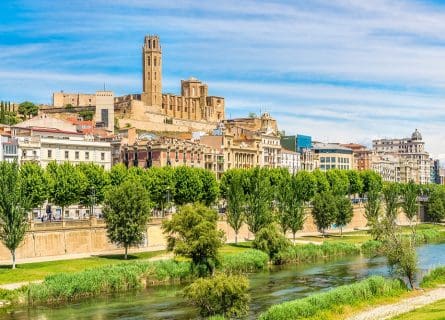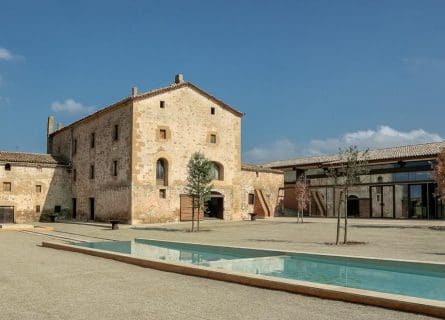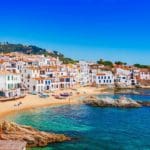Costers del Segre Wine Region Guide
Discover Elegance in Every Sip: Catalunya's Hidden Gem
EXPLORE ALL OUR CATALUNYA WINE REGIONS GUIDE
Last updated: October 11, 2024
Introduction
Until recently, Costers del Segre was one of Catalunya’s more obscure regions despite the laudable efforts of the sizable Raimat estate. Then, the Torres family announced they were investing in this corner of northeastern Spain, and everything changed. CEO Miguel Torres Maczassek said the Pallars subzone of Costers del Segre “is one of the great untapped resources in Catalan viticulture.” To that end, Torres planted a collection of French varieties – Sauvignon Blanc, Chardonnay, Pinot Noir, and Merlot were among them – in addition to some pre-phylloxera Spanish grapes.
Fast-forward eight years, and the DO has been transformed beyond recognition—a great deal of critical buzz has put Costers del Segre on the international map. Due to the incredibly varied topography, local winemakers can fashion a wide range of styles in this trendy appellation. Take your pick.
Discover more about Spanish Wine
History

The Phoenicians were among the earliest seafarers to reach the Iberian Peninsula, with the Greeks arriving later. By the 6th century BC, Carthage, once a Phoenician colony, became dominant. However, the Second Punic War ended with the Romans establishing themselves in Hispania for over 600 years, ushering in the ‘Pax Romana’ era.
By the 5th century, Rome weakened, and the Visigoths, Germanic tribes from the north, took over. They allied with the Hispano-Roman elites, bringing a phase of political stability. However, by 718, the Islamic army from North Africa, led by Tariq ibn Ziyad, conquered Catalunya. Most of it was recaptured by Christians within 70 years, creating a de facto boundary with Moorish regions.
Expansion and Absorption into Castile
Thanks to its strong navy, Catalunya expanded its territory after the caliphate’s disintegration into Taifas. Yet, its autonomy was short-lived. After allying with Aragon in the 12th century, Catalunya was eventually absorbed into the Castilian state through the marriage of Fernando of Aragon and Isabel of Castile in 1469. These monarchs, known for ending Muslim rule in Granada and establishing the Spanish Inquisition, also sponsored Columbus’ voyages, leading to Spain’s global empire.
Subsequent Habsburg rulers spent Spain’s wealth on luxuries and wars. The Bourbon era, particularly under Felipe V, revived regions like Catalunya, which became an industrial center in the 1800s. Despite challenges like the phylloxera louse affecting winegrowing, Catalunya remained resilient, adapting methods like regrafting European vines onto American rootstock.
However, many vineyards in Costers del Segre were replaced with olive trees, as they were considered a more economically sound crop. Then, in 1986, the region was awarded DO status; the appellation remained largely unknown outside Catalunya until the early 21st century. Its most famous producer has long been Raimat, established by Manuel Raventós i Domènech in 1914.
Today, the property cultivates 3,000 hectares of organic vineyards in the arid expanse of Lleida – a poster child for the area’s potential. But Tomàs Cusiné, Torres, and Castell d’Encus have also done much to further the DO’s reputation abroad.
Geography and terroir

Flanked by the western Pyrenees, Costers del Segre is Catalunya’s most isolated vineyard. To the west is the province of Aragon – the Segre River (from which the region takes its name) joins the Ebro just south of Lleida. And with so much to offer along the coast and in Barcelona, most travelers tend not to bother much with Catalunya’s interior. More fool them: this is a sparsely populated and beautiful region, largely tourist-free.
Diversity of Vines and Challenging Climate
Vines grow in all directions in the Segre River valley, which is divided into seven widely scattered subzones:
- Artesa de Segre
- Les Garrigues
- Pallars Jussa
- Raimat, Segria
- Valls del Riucorb
- Urgell
As a result, soils and growing conditions can vary significantly between different zones, although the overall climate has been described as “harsh” by many residents.
Of course, they refer to the semi-arid, continental climate of Costers del Segre: scorching summers and bitterly cold winters. Indeed, to the untrained eye, Costers del Segre is an unlikely winegrowing destination – a place where making fresh and balanced wines should be impossible.
Yet it isn’t. As Codorniu’s head winemaker Bruno Colomer so eloquently observed:
“We have to keep in mind that Costers de Segre offers a very particular climate and soil. The region’s continental climate – depending on the distance to the sea – can be beneficial for optimal ripening; its ‘secret’ is the fluctuating temperatures between day and night which have a positive effect on grape maturation.”
Growers regard this diurnal variation as their most important natural advantage; in specific high-altitude sites, the temperature variance can sometimes be higher than 68°F. Without this elevation, acidity would be scarce in Costers del Segre. Nevertheless, irrigation is essential in certain parts of the DO.
Winemaking and regional classifications
With many grape varieties and terroirs at their disposal, winegrowers in Costers del Segre like to market a broad spectrum of styles. This vinous diversity is positively encouraged by the DO—red, white, and rosado (rosé) wines are given equal billing here. A growing volume of grapes are also used to produce sparkling wine in Costers del Segre, marketed under the auspices of the Cava appellation.
High-altitude sites and old Xarel-lo bush vines are in great demand in the zone. The best examples can rival the tremendous efforts of Gramona and Recaredo in the more established vineyards of Penedes.
Dominance of Still Wines
However, still wines are far more important in terms of sales – both at home and abroad. Today, some of the finest reds are being made in the Garrigues subregion, just over the Montsant range from Priorat, and the terrain is not dissimilar. These Grenache-dominant cuvées can offer exceptional value: spicy, potent, and gloriously rich. Under the DO rules, they can be sold as Crianzas (two years aging before release) or Gran Reservas (five years maturation before being sold).
The use of oak is commonplace in Costers de Segre, particularly for Grenache, Carignan, and Monastrell blends. They are increasingly joined by excellent Tempranillo reds, sometimes mixed with international grapes like Cabernet Sauvignon and Syrah. The Vall del Riucorb subzone has shown great promise for Bordeaux’s premier red grape; Artesa de Segre offers ripe flavors and silky textures.
Meanwhile, old vine Macebeo and Xarel-lo steal the show in Pallars Jussa. But, for many consumers, Raimat’s vast range of varietal wines is the safest bet. The surprises are admittedly few, but Raimat is hard to beat for quality and consistency.
Facts & Figures
Key wine styles
- Full-bodied red, white, and rosé wines; sparkling Cava
Appellation structure
- DO Costers del Segre
Hectares under vine
- 4000
Average annual production
- 30,000 hectoliters per annum
Approximate number of wineries
- 40
The lowdown

Costers de Segre emerged in the 1990s as an ambitious producer in the Spanish wine world. All it lacked was a collection of recognized brands – something Raimat and, more recently, Miguel Torres have worked hard to remedy. This family company broke new ground with the release of Purgatori, a beguiling concoction of Syrah, Carignan, and Grenache.
This powerful and concentrated red – expect oodles of garrigue, red fruit, and cassis on the palate – seems to have caught the imagination of buyers and the wine-drinking public. It has helped spread the renown of Catalunya’s most underrated viticultural resource.
Evolving Reputation and Wine Diversity
However, this is changing. The region is buoyant with new wineries and experimentation with pre-phylloxera varieties; the accusation that Costers del Segre “is more New World than Catalan” is no longer valid. True, the DO is not a fertile source of icon wines and lavishly expensive labels – head to Priorat if you want to spend serious sums. But greatness is not just about scarcity or prestige.
The vast majority of wines made in Costers del Segre are bottles to be enjoyed and not hidden away: well-made, delicious, and suited to a wide range of cuisines. It has become one of Catalunya’s most reliable sources of excellent vino. Let’s celebrate it.
Key Grape Varietals
-
Chardonnay
Chardonnay is a green-skinned grape varietal native to the Burgundy wine region in France and one of the most popular varieties worldwide.
Find out more -
Macabeo (Viura)
Discover Viura: Rioja's Prominent White Grape & Catalonia's Macabeo. Explore its versatility in exquisite wines. A must-read for wine enthusiasts.
Find out more -
Moscatel (Muscat)
The Moscatel grape, renowned for its aromatic allure and luscious sweetness, also plays a significant role in the world of Sherry. This versatile grape variety contributes to the creation of exceptional Sherries, adding depth, complexity, and a touch of honeyed richness to these fortified wines.
-
Parellada
Unveil the allure of Parellada grape: a Spanish gem crafting elegant sparkling & white wines. Explore its unique qualities & flavor profile.
Find out more -
Riesling
Discover Riesling's charm, a white grape from Germany's Rhine region, cherished in Alsace, France. Unveil its secrets and delights
Find out more -
Sauvignon Blanc
The sauvignon blanc grape varietal, originally from the Bordeaux region of France, is now one of the world's most loved white varieties.
Find out more -
Xarel-lo
Unveiling Xarel-lo: A Key Grape in Catalonia's Cava Sparkling Wine. Discover the Intriguing Role of Xarel-lo in Spain's Sparkling Delight.
Find out more -
Carieña (Carignan)
Carignan is a red grape variety that grows mostly in Southern France, and is often used as a blending grape
Find out more -
Cabernet Sauvignon
Discover the irresistible allure of Cabernet Sauvignon—a worldwide favorite with robust, dark-bodied flavor. Unleash your wine journey today!
Find out more -
Garnacha Tinta (Grenache Noir)
Garnacha: Spain's Red Gem. Akin to Pinot Noir, it bridges terroir and winemaking, crafting captivating expressions.
Find out more -
Merlot
Merlot is the most cultivated grape in Bordeaux and closely related to Cabernet Franc
Find out more -
Monastrell
Unveiling Spain's Hidden Gold: Monastrell Wine - Explore the Richness and Allure of this Exceptional Varietal
Find out more -
Pinot Noir
Pinot noir is a light-bodied red wine varietal closely related to the Vitis vinifera grape and produces the most sought-after red wines in the world.
Find out more -
Syrah
Syrah is dark-skinned and perhaps the most underrated of the 'noble' red grape varieties.
Find out more -
Trepat
Trepat is a red grape variety native to northeastern Spain, specifically the Catalonia region. It produces light-to-medium-bodied wines with low tannins and high acidity, making them particularly well-suited to sparkling wine production. Trepat is gaining popularity among wine enthusiasts for its unique flavor profile and versatility in winemaking.
-
Tempranillo
Discover Tempranillo: Spain's iconic red grape. From Ribera del Duero to Toro, it yields concentrated wines. Explore its synonyms and unleash its prowess.
Find out more
Costers del Segre gastronomy
The interior of central Catalunya offers a wide variety of gastronomic pleasures, from lamb grazed on the Pyrenean foothills to freshwater fish of the Segre. Lleida serves up the most enticing options in this part of rural Catalunya; the city is the province’s snail-eating capital. Indeed, endless cargols are consumed during May’s annual Aplec del Cargol snail fest. But delicious tapas (of the non-snail variety) are also abundant for those who prefer not to gorge on gastropods.
Catalan Gastronomy Guide: Read more
Cellar Tour's Selection of Top Wineries in the Region
-
Miguel Torres
The Torres family has been cultivating their own vineyards in the beautiful, Mediterranean region of Penedès for the last 300 years. Read more -
Raimat
Read more -
Castell del Remei
Read more -
Cérvoles Celler
Read more -
Tomàs Cusiné
Read more -
L'Olivera Cooperativa
Read more
More information
If you would like us to customize an exclusive luxury tour, contact us and let us know your travel plans. We offer luxury food and wine tours for private groups of a mininium two guests. In addition, all of our private, chauffeured tours are available year-round upon request.



